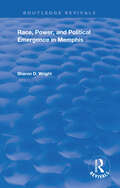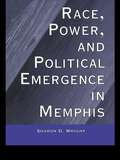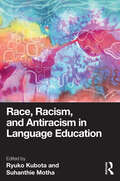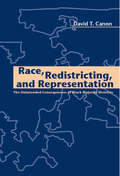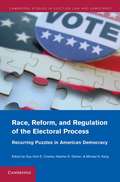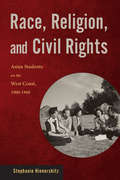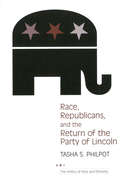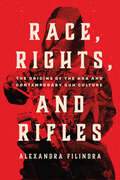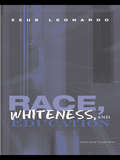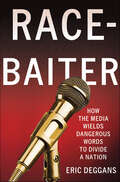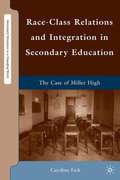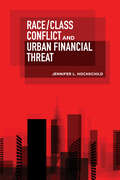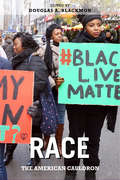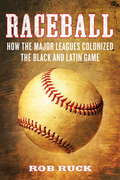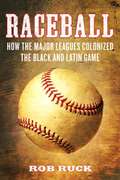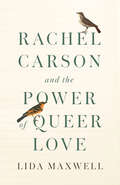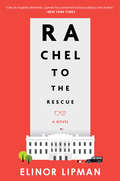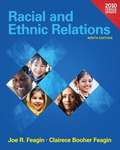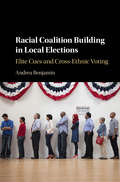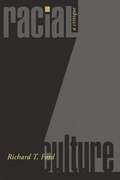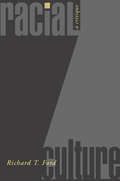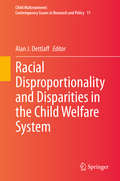- Table View
- List View
Race, Power, and Political Emergence in Memphis (Race And Politics Ser.)
by Sharon D. WrightRace, Power, and Political Emergence in Memphis examines black political behavior and empowerment strategies in the city of Memphis. Each chapter of the text focuses on three themes-mobilization, emergence, and incorporation. By analyzing the effects of race on black political development in Memphis, scholars will be able to examine broader questions about its effects in other cities. How do political machines use substantial black electorates to their advantage? What forms of protest do black communities conduct to rebel against machine rule? What primary mobilization tactics have black citizens used during the different periods of their political development? Why do blacks mobilize more quickly in some cities? In cities with large and predominantly black populations, what elements prevent black candidates from winning citywide races? What constraints do newly elected black mayors face? What benefits do black citizens gain from their representation? After a predominantly black governing coalition is elected, what obstacles remain? Can black citizens translate proportional representation into strong political incorporation? How much power can African Americans realistic expect to gain in cities? This book is the most comprehensive case study of the city's political scene written to date. The text primarily shows that white racism is not the only obstacle to black political development. Black citizens can have population majorities, but lose elections for other reasons. Their ability to win elections and gain full incorporation depends heavily on whether they minimize internal conflict and establish coalitions with middle-class citizens and the business establishment.
Race, Power, and Political Emergence in Memphis (Race and Politics)
by Sharon D. WrightRace, Power, and Political Emergence in Memphis examines black political behavior and empowerment strategies in the city of Memphis. Each chapter of the text focuses on three themes-mobilization, emergence, and incorporation. By analyzing the effects of race on black political development in Memphis, scholars will be able to examine broader questions about its effects in other cities. How do political machines use substantial black electorates to their advantage? What forms of protest do black communities conduct to rebel against machine rule? What primary mobilization tactics have black citizens used during the different periods of their political development? Why do blacks mobilize more quickly in some cities? In cities with large and predominantly black populations, what elements prevent black candidates from winning citywide races? What constraints do newly elected black mayors face? What benefits do black citizens gain from their representation? After a predominantly black governing coalition is elected, what obstacles remain? Can black citizens translate proportional representation into strong political incorporation? How much power can African Americans realistic expect to gain in cities? This book is the most comprehensive case study of the city's political scene written to date. The text primarily shows that white racism is not the only obstacle to black political development. Black citizens can have population majorities, but lose elections for other reasons. Their ability to win elections and gain full incorporation depends heavily on whether they minimize internal conflict and establish coalitions with middle-class citizens and the business establishment.
Race, Racism, and Antiracism in Language Education
by Ryuko Kubota Suhanthie MothaBuilding on the pioneering 2009 volume, Race, Culture, and Identities in Second Language Education, this book reflects the significant expansion in the research since its publication and offers a wider breadth of perspectives on the complex theoretical terrain of race, racism, and antiracism in language education.Contributors to this book apply a range of conceptual and methodological lenses to teaching diverse world languages. Underscoring the interconnectedness of race and colonialism, world language education, and intersectional ideologies, this book offers a forum for engaged dialogues among teachers, teacher educators, teacher candidates, graduate and advanced undergraduate students, curriculum developers, policymakers, and educational researchers in a wide range of disciplines, including language education. In covering important theoretical frames and constructs—including raciolinguistic and anti-oppressive pedagogies, decoloniality, neoliberalism, and reverse linguistic stereotyping—this book breaks from the Global North norms in applied linguistics and language instruction.An essential text in TESOL and world language education, this volume weaves meaningful connections among language education, language-in-education policy, and research.
Race, Redistricting, and Representation: The Unintended Consequences Of Black Majority Districts (American Politics And Political Economy Ser.)
by David T. CanonSince the creation of minority-dominated congressional districts eight years ago, the Supreme Court has condemned the move as akin to "political apartheid," while many African-American leaders argue that such districts are required for authentic representation. <P><P> In the most comprehensive treatment of the subject to date, David Canon shows that the unintended consequences of black majority districts actually contradict the common wisdom that whites will not be adequately represented in these areas. Not only do black candidates need white votes to win, but this crucial "swing" vote often decides the race. And, once elected, even the black members who appeal primarily to black voters usually do a better job than white members of walking the racial tightrope, balancing the needs of their diverse constituents. <P><P> Ultimately, Canon contends, minority districting is good for the country as a whole. These districts not only give African Americans a greater voice in the political process, they promote a politics of commonality—a biracial politics—rather than a politics of difference.
Race, Redistricting, and Representation: The Unintended Consequences Of Black Majority Districts (American Politics And Political Economy Ser.)
by David T. CanonRace, Redistricting, and Representation: The Unintended Consequences of Black Majority Districts (American Politics And Political Economy Ser.)
by David T. CanonSince the creation of minority-dominated congressional districts eight years ago, the Supreme Court has condemned the move as akin to "political apartheid," while many African-American leaders argue that such districts are required for authentic representation. In the most comprehensive treatment of the subject to date, David Canon shows that the unintended consequences of black majority districts actually contradict the common wisdom that whites will not be adequately represented in these areas. Not only do black candidates need white votes to win, but this crucial "swing" vote often decides the race. And, once elected, even the black members who appeal primarily to black voters usually do a better job than white members of walking the racial tightrope, balancing the needs of their diverse constituents. Ultimately, Canon contends, minority districting is good for the country as a whole. These districts not only give African Americans a greater voice in the political process, they promote a politics of commonality—a biracial politics—rather than a politics of difference.
Race, Reform, and Regulation of the Electoral Process
by Guy-Uriel E. Charles Heather K. Gerken Michael S. KangThis book offers a critical re-evaluation of three fundamental and interlocking themes in American democracy: the relationship between race and politics, the performance and reform of election systems, and the role of courts in regulating the political process. This edited volume features contributions from some of the leading voices in election law and social science. The authors address the recurring questions for American democracy and identify new challenges for the twenty-first century. They not only consider where current policy and scholarship is headed, but also suggest where it ought to go over the next two decades. The book thus provides intellectual guideposts for future scholarship and policymaking in American democracy.
Race, Religion, and Civil Rights
by Stephanie HinnershitzHistories of civil rights movements in America generally place little or no emphasis on the activism of Asian Americans. Yet, as this fascinating new study reveals, there is a long and distinctive legacy of civil rights activism among foreign and American-born Chinese, Japanese, and Filipino students, who formed crucial alliances based on their shared religious affiliations and experiences of discrimination. Stephanie Hinnershitz tells the story of the Asian American campus organizations that flourished on the West Coast from the 1900s through the 1960s. Using their faith to point out the hypocrisy of fellow American Protestants who supported segregation and discriminatory practices, the student activists in these groups also performed vital outreach to communities outside the university, from Californian farms to Alaskan canneries. Highlighting the unique multiethnic composition of these groups, Race, Religion, and Civil Rights explores how the students' interethnic activism weathered a variety of challenges, from the outbreak of war between Japan and China to the internment of Japanese Americans during World War II. Drawing from a variety of archival sources to bring forth the authentic, passionate voices of the students, Race, Religion, and Civil Rights is a testament to the powerful ways they served to shape the social, political, and cultural direction of civil rights movements throughout the West Coast.
Race, Religion, and Civil Rights: Asian Students on the West Coast, 1900-1968
by Stephanie HinnershitzHistories of civil rights movements in America generally place little or no emphasis on the activism of Asian Americans. Yet, as this fascinating new study reveals, there is a long and distinctive legacy of civil rights activism among foreign and American-born Chinese, Japanese, and Filipino students, who formed crucial alliances based on their shared religious affiliations and experiences of discrimination. Stephanie Hinnershitz tells the story of the Asian American campus organizations that flourished on the West Coast from the 1900s through the 1960s. Using their faith to point out the hypocrisy of fellow American Protestants who supported segregation and discriminatory practices, the student activists in these groups also performed vital outreach to communities outside the university, from Californian farms to Alaskan canneries. Highlighting the unique multiethnic composition of these groups, Race, Religion, and Civil Rights explores how the students' interethnic activism weathered a variety of challenges, from the outbreak of war between Japan and China to the internment of Japanese Americans during World War II. Drawing from a variety of archival sources to bring forth the authentic, passionate voices of the students, Race, Religion, and Civil Rights is a testament to the powerful ways they served to shape the social, political, and cultural direction of civil rights movements throughout the West Coast.
Race, Republicans, & the Return of the Party of Lincoln
by Tasha S. PhilpotWhether their slogan is “compassionate conservatism” or “hawkish liberalism,” political parties have always sought to expand their electoral coalitions by making minor adjustments to their public image. How do voters respond to these, often short-term, campaign appeals? Race, Republicans, and the Return of the Party of Lincoln is Tasha Philpot’s insightful study of how parties use racial images to shape and reshape the way citizens perceive them.
Race, Rights, and Rifles: The Origins of the NRA and Contemporary Gun Culture (Chicago Studies in American Politics)
by Alexandra FilindraAn eye-opening examination of the ties between American gun culture and white male supremacy from the American Revolution to today. One-third of American adults—approximately 86 million people—own firearms. This is not just for protection or hunting. Although many associate gun-centric ideology with individualist and libertarian traditions in American political culture, Race, Rights, and Rifles shows that it rests on an equally old but different foundation. Instead, Alexandra Frilindra shows that American gun culture can be traced back to the American Revolution when republican notions of civic duty were fused with a belief in white male supremacy and a commitment to maintaining racial and gender hierarchies. Drawing on wide-ranging historical and contemporary evidence, Race, Rights, and Rifles traces how this ideology emerged during the Revolution and became embedded in America’s institutions, from state militias to the National Rifle Association (NRA). Utilizing original survey data, Filindra reveals how many White Americans —including those outside of the NRA’s direct orbit—embrace these beliefs, and as a result, they are more likely than other Americans to value gun rights over voting rights, embrace antidemocratic norms, and justify political violence.
Race, Whiteness, and Education (Critical Social Thought)
by Zeus LeonardoIn the colorblind era of Post-Civil Rights America, race is often wrongly thought to be irrelevant or, at best, a problem of racist individuals rather than a systemic condition to be confronted. Race, Whiteness, and Education interrupts this dangerous assumption by reaffirming a critical appreciation of the central role that race and racism still play in schools and society. Author Zeus Leonardo’s conceptual engagement of race and whiteness asks questions about its origins, its maintenance, and envisages its future. This book does not simply rehearse exhausted ideas on the relationship among race, class, and education, but instead offers new ways of understanding how multiple social relations interact with one another and of their impact in thinking about a more genuine sense of multiculturalism. By asking fundamental questions about whiteness in schools and society, Race, Whiteness, and Education goes to the heart of race relations and the common sense understandings that sustain it, thus painting a clearer picture of the changing face of racism.
Race-Baiter: How the Media Wields Dangerous Words to Divide a Nation
by Eric DeggansGone is the era of Edward R. Murrow and Walter Cronkite, when news programs fought to gain the trust and respect of a wide spectrum of American viewers. Today, the fastest-growing news programs and media platforms are fighting hard for increasingly narrow segments of the public and playing on old prejudices and deep-rooted fears, coloring the conversation in the blogosphere and the cable news chatter to distract from the true issues at stake. Using the same tactics once used to mobilize political parties and committed voters, they send their fans coded messages and demonize opposing groups, in the process securing valuable audience share and website traffic. Race-baiter is a term born out of this tumultuous climate, coined by the conservative media to describe a person who uses racial tensions to arouse the passion and ire of a particular demographic. Even as the election of the first black president forces us all to reevaluate how we think about race, gender, culture, and class lines, some areas of modern media are working hard to push the same old buttons of conflict and division for new purposes. In Race-Baiter, veteran journalist and media critic Eric Deggans dissects the powerful ways modern media feeds fears, prejudices, and hate, while also tracing the history of the word and its consequences, intended or otherwise.
Race-Class Relations and Integration in Secondary Education
by Caroline EickEick explores the history of a comprehensive high school from the world views of its assorted student body, confronting issues of race, ethnicity, class, gender, nationality, and religion. Her case study examines the continuities and differences in student relationships over five decades.
Race/Class Conflict and Urban Financial Threat
by Jennifer L. HochschildRace and class inequality are at the crux of many policy disputes in American cities. But are they the only factors driving political discord? In Race/Class Conflict and Urban Financial Threat, political scientist Jennifer L. Hochschild examines significant policies in four major American cities to determine when race and class shape city politics, when they do not, and what additional forces have the power to shape urban policy choices. Hochschild investigates the root causes of disputes in the arenas of policing, development, schooling, and budgeting. She finds that race and class are central to the Stop-Question-Frisk policing policy in New York City and the development of Atlanta’s Beltline. New York’s Stop-Question-Frisk policy was intended to fight crime and keep all New Yorkers safe. In practice, however, young Black and Latino men in low-income neighborhoods were disproportionately stopped by a predominantly White police force. The goal of the Atlanta Beltline, a redevelopment project that includes public parks, new housing, commercial development, and a robust public transit system, is to expand access around the city and keep working-class residents in the city by constructing affordable housing. Instead, the construction completed thus far has encouraged gentrification and displacement of poor, disproportionately Black residents, and has increased the wealth and power of both Black and White city elites. However, Hochschild finds that race and class inequality are not central to all urban policy disputes. When investigating the issues of charter schools in Los Angeles and Chicago’s pension system she identifies a third driver: financial threat that feels existential to the policy and political actors. In Los Angeles, there is a battle between traditional public schools and independent charter schools. Increasingly, families with sufficient resources are moving out of L.A. to areas with better school districts. Traditional public schools and charter schools must fight for the remaining students and the funding that comes with them. There are not enough students to teach and not enough money to teach them. The school district risks school closures, layoffs, and pension deficits; in this context, race/class conflict fades into the background. Chicago’s public sector pension debt is at least three times as large as the city’s annual budget and continues to grow. Policy actors agree that the pension system needs to be stably funded. Yet city leaders, fearful of upsetting constituents and jeopardizing their political careers, fail to implement policies that would do so. Meaningful policy change to rectify the pension deficit continues to get kicked down the line for future policy actors to address. In this context also, race/class conflict fades into the background. Race/Class Conflict and Urban Financial Threat is a compelling examination of the role that race, class, and political and fiscal threat play in shaping urban policy.
Race: The American Cauldron (Miller Center Studies on the Presidency)
by Michael Eric Dyson Orlando Patterson Douglas A. Blackmon Elizabeth HintonIn an increasingly polarized political environment, the first year of the new president’s term will be especially challenging. With a fresh mandate, however, the first year also offers opportunities that may never come again. The First Year Project is a fascinating initiative by the Miller Center of the University of Virginia that brings together top scholars on the American presidency and experienced officials to explore the first twelve months of past administrations, and draw practical lessons from that history, as we inaugurate a new president in January 2017.This project is the basis for a new series of digital shorts published as Miller Center Studies on the Presidency. Presented as specially priced collections published exclusively in an ebook format, these timely examinations recognize the experiences of past presidents as an invaluable resource that can edify and instruct the incoming president.Contributors: Michael Eric Dyuson, Georgetown University * Elizabeth Hinton, Harvard University * Orlando Patterson, Harvard University * Douglas A. Blackmon, Georgia State University
Raceball
by Rob RuckFrom an award-winning writer, the first linked history of African Americans and Latinos in Major League BaseballAfter peaking at 27 percent of all major leaguers in 1975, African Americans now make up less than one-tenth--a decline unimaginable in other men's pro sports. The number of Latin Americans, by contrast, has exploded to over one-quarter of all major leaguers and roughly half of those playing in the minors. Award-winning historian Rob Ruck not only explains the catalyst for this sea change; he also breaks down the consequences that cut across society. Integration cost black and Caribbean societies control over their own sporting lives, changing the meaning of the sport, but not always for the better. While it channeled black and Latino athletes into major league baseball, integration did little for the communities they left behind. By looking at this history from the vantage point of black America and the Caribbean, a more complex story comes into focus, one largely missing from traditional narratives of baseball's history. Raceball unveils a fresh and stunning truth: baseball has never been stronger as a business, never weaker as a game.
Raceball: How the Major Leagues Colonized the Black and Latin Game
by Rob RuckFrom an award-winning writer comes the first linked history of African Americans and Latinos in Major League Baseball.
Rachel Carson and the Power of Queer Love
by Lida MaxwellHow Silent Spring stands as a monument to a unique, loving relationship between Rachel Carson and Dorothy Freeman, and how such love underpins a new environmental politics After the success of her first bestseller, The Sea Around Us, Rachel Carson settled in Southport, Maine. The married couple Dorothy and Stanley Freeman had a cottage nearby, and the trio quickly became friends. Their extensive and evocative correspondence shows that Dorothy and Rachel did something more: they fell in love. In this moving new book, Lida Maxwell explores their letters to reveal how Carson's masterpiece, Silent Spring, grew from the love these women shared for their wild surroundings and, vitally and increasingly, for each other. Carson had already demonstrated a profound environmental awareness by the time she purchased her home in Maine; Maxwell proposes that it took her love for Dorothy to open up a more powerful space for critique. As their love unsettled their heteronormative ideas of bourgeois life, it enabled Carson to develop an increasingly critical view of capitalism and its effects on nonhuman nature and human lives alike, and it was this evolution that made the advocacy of Silent Spring possible. In Rachel Carson and the Power of Queer Love, Silent Spring's exposé of the dangerous and loveless exhaustion of nature for capitalism's ends is set in bold relief against the lovers' correspondence, in which we see the path toward a more loving use of nature and a transformative political desire that, Maxwell argues, should inform our approach to contemporary environmental crises.
Rachel to the Rescue
by Elinor LipmanRachel Klein is sacked from her job at the White House after she sends an email criticizing Donald Trump. As she is escorted off the premises she is hit by a speeding car, driven by what the press will discreetly call "a personal friend of the President." Does that explain the flowers, the get-well wishes at a press briefing, the hush money offered by a lawyer at her hospital bedside? Rachel&’s recovery is soothed by comically doting parents, matchmaking room-mates, a new job as aide to a journalist whose books aim to defame the President, and unexpected love at the local wine store. But secrets leak, and Rachel&’s new-found happiness has to make room for more than a little chaos. Will she bring down the President? Or will he manage to do that all by himself? Rachel to the Rescue is a mischievous political satire, with a delightful cast of characters, from one of America&’s funniest novelists.
Racial And Ethnic Relations: Census Update
by Joe R. Feagin Clairece Booher FeaginRacial and Ethnic Relations, 9/e examines the "what", "why", and "how" of racial and ethnic oppression and conflict. Drawing on a broad array of sources, this text provides readers with access to important research and literature on racial and ethnic groups in the United States and, to a lesser extent, in certain other countries around the globe. It is designed for courses in Majority-Minority Relations, Racial and Ethnic Relations, Cultural Diversity, and Multiculturalism in departments of Sociology and Ethnic Studies. The Census Update program incorporates 2010 Census data into a course--simply and easily. The components of the Census Update Program include an updated census edition with all charts and graphs--to reflect the results of the 2010 Census.
Racial Coalition Building in Local Elections: Elite Cues and Cross-Ethnic Voting
by Andrea BenjaminThis book examines racial and ethnic coalition building in local elections and considers Black and Latino political incorporation more broadly. Although many argue that Black and Latino voters have much to gain from alliances that advance shared interests, coalitions between the two groups have not always formed easily or been stable over time. Recent mayoral elections across the country show different patterns of out-group candidate support. This book seeks to explain these variations and the specific conditions under which Blacks and Latinos vote for the same candidate. Drawing on large-n observational data, survey experiments, and qualitative case studies, Benjamin develops a theory of co-ethnic endorsements, which points to the significance of elite cues from Black and Latino leaders. The book demonstrates that voters use elite co-ethnic endorsements to help inform their votes, that they do so particularly when race is salient in an election, and that this has real implications for representation and access to political benefits.
Racial Culture: A Critique
by Richard T. FordWhat is black culture? Does it have an essence? What do we lose and gain by assuming that it does, and by building our laws accordingly? This bold and provocative book questions the common presumption of political multiculturalism that social categories such as race, ethnicity, gender, and sexuality are defined by distinctive cultural practices. Richard Ford argues against law reform proposals that would attempt to apply civil rights protections to "cultural difference." Unlike many criticisms of multiculturalism, which worry about "reverse discrimination" or the erosion of core Western cultural values, the book's argument is primarily focused on the adverse effects of multicultural rhetoric and multicultural rights on their supposed beneficiaries. In clear and compelling prose, Ford argues that multicultural accounts of cultural difference do not accurately describe the practices of social groups. Instead these accounts are prescriptive: they attempt to canonize a narrow, parochial, and contestable set of ideas about appropriate group culture and to discredit more cosmopolitan lifestyles, commitments, and values. The book argues that far from remedying discrimination and status hierarchy, "cultural rights" share the ideological presuppositions, and participate in the discursive and institutional practices, of racism, sexism, and homophobia. Ford offers specific examples in support of this thesis, in diverse contexts such as employment discrimination, affirmative action, and transracial adoption. This is a major contribution to our understanding of today's politics of race, by one of the most distinctive and important young voices in America's legal academy.
Racial Culture: A Critique
by Richard T. FordWhat is black culture? Does it have an essence? What do we lose and gain by assuming that it does, and by building our laws accordingly? This bold and provocative book questions the common presumption of political multiculturalism that social categories such as race, ethnicity, gender, and sexuality are defined by distinctive cultural practices. Richard Ford argues against law reform proposals that would attempt to apply civil rights protections to "cultural difference." Unlike many criticisms of multiculturalism, which worry about "reverse discrimination" or the erosion of core Western cultural values, the book's argument is primarily focused on the adverse effects of multicultural rhetoric and multicultural rights on their supposed beneficiaries. In clear and compelling prose, Ford argues that multicultural accounts of cultural difference do not accurately describe the practices of social groups. Instead these accounts are prescriptive: they attempt to canonize a narrow, parochial, and contestable set of ideas about appropriate group culture and to discredit more cosmopolitan lifestyles, commitments, and values. The book argues that far from remedying discrimination and status hierarchy, "cultural rights" share the ideological presuppositions, and participate in the discursive and institutional practices, of racism, sexism, and homophobia. Ford offers specific examples in support of this thesis, in diverse contexts such as employment discrimination, affirmative action, and transracial adoption. This is a major contribution to our understanding of today's politics of race, by one of the most distinctive and important young voices in America's legal academy.
Racial Disproportionality and Disparities in the Child Welfare System (Child Maltreatment #11)
by Alan J. DettlaffThis volume examines existing research documenting racial disproportionality and disparities in child welfare systems, the underlying factors that contribute to these phenomena and the harms that result at both the individual and community levels. It reviews multiple forms of interventions designed to prevent and reduce disproportionality, particularly in states and jurisdictions that have seen meaningful change. With contributions from authorities and leaders in the field, this volume serves as the authoritative volume on the complex issue of child maltreatment and child welfare. It offers a central source of information for students and practitioners who are seeking understanding on how structural and institutional racism can be addressed in public systems.
